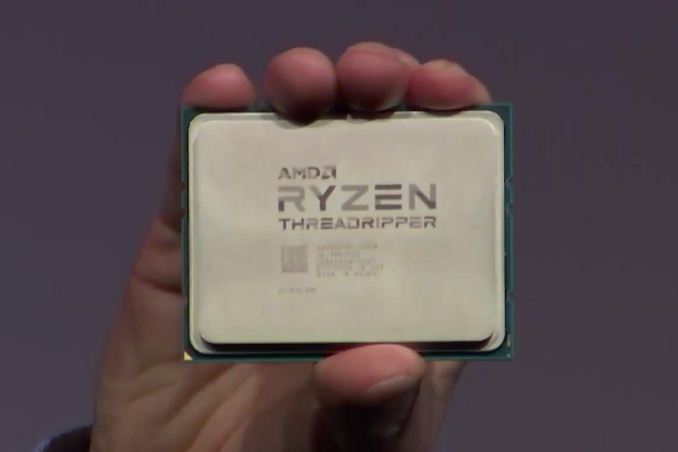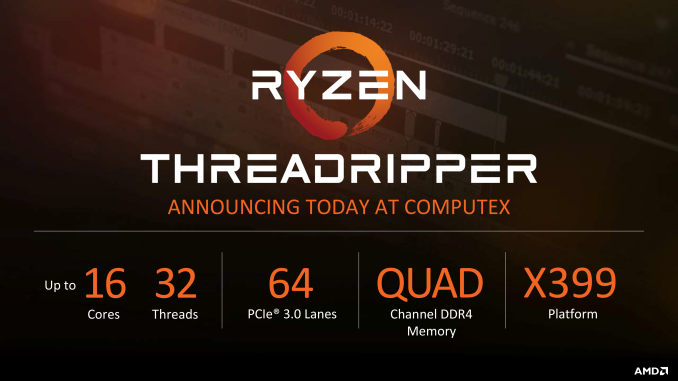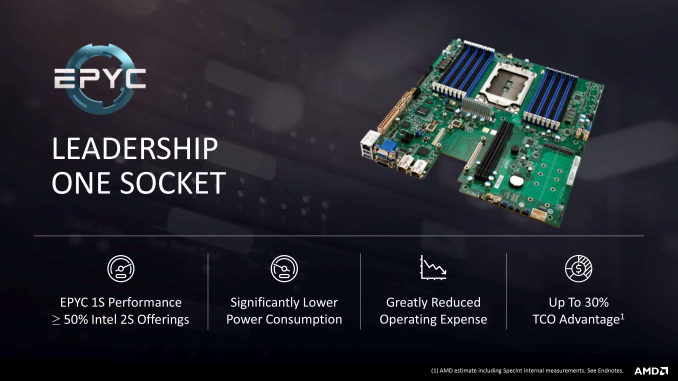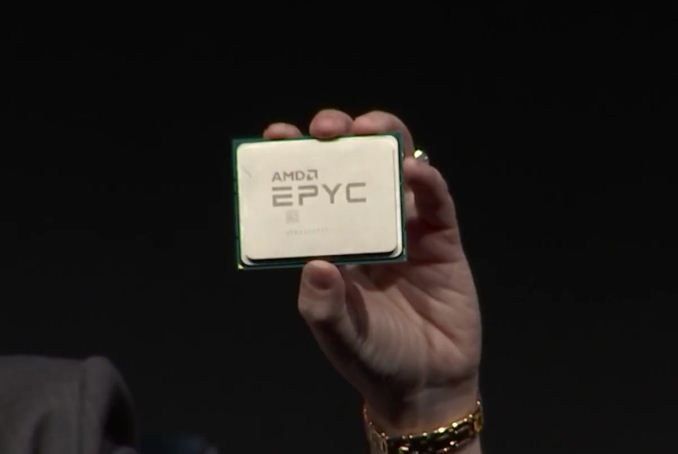AMD CPU Updates: 16 Core ThreadRipper w/64 PCIe Lanes This Summer, Epyc Launching June 20th
by Ryan Smith on May 30, 2017 11:57 PM EST- Posted in
- CPUs
- AMD
- Computex 2017
- ThreadRipper
- EPYC

Wrapping up just a bit ago was AMD’s annual Computex press conference. AMD brings their A-game to Computex, and for a good reason: as a PC focused show, it gives them great exposure, but it also allows them to promote their OEM relationships, the latter of which are crucial to AMD’s survival as the CPU underdog. Computex in turn isn’t a venue for deep technical announcements, but it’s a good place to get clarity on AMD’s CPU roadmap.
Starting things off then, let’s talk about ThreadRipper. AMD’s previously announced many-core CPU for the high-end PC desktop and workstation market was first announced at Financial Analyst Day a few weeks back. AMD is now in the process of slowly releasing information about the chip to build up interest ahead of its launch – which, before you ask, hasn’t been set yet and is still “this summer”.
At today’s press conference, AMD has confirmed that the 16 core processor will for most purposes be half of an Epyc processor. This means that the two die MCM chip will feature 4 DDR4 channels and a whopping 64 lanes of PCIe, with all 64 lanes being enabled for all ThreadRipper SKUs. This will be broken up into 60+4: 60 lanes directly from the CPU for feeding PCIe and M.2 slots, and then another 4 lanes going to the chipset (with an undisclosed number of lanes then coming off of it) to drive basic I/O, USB, and other features. AMD seems to be particularly relishing the point on PCIe lanes in light of the yesterday’s Intel HEDT announcement, which maxes out at 44 lanes and no chip below $1000 actually has all of them enabled.
The launch chipset for ThreadRipper will be the X399 chipset (ed: at this point AMD and Intel are literally trying to one-up each other). No details have been released on it thus far, so we’ll have to see what AMD has up their sleeve. But coming so close to the Ryzen launch, it doesn’t sound like it’ll be radically different. Otherwise we’re hoping to grab some pictures of X399 boards at the show today, as those should be on display. The ThreadRipper/Epyc socket in particular should be interesting; the chip is nothing short of massive, and in the one photo AMD has released so far of an Epyc motherboard, the socket looks equally huge.
Finally, not to be outdone, AMD’s 32 core & 128 PCIe lane Epyc CPU for servers has also received some news of its own. AMD’s first promising product in the server space in nearly half a decade will be launching on June 20th.













71 Comments
View All Comments
Freakie - Wednesday, May 31, 2017 - link
That is an INSANELY large package for 16 cores. I mean, holy crap just LOOK AT IT!boozed - Wednesday, May 31, 2017 - link
It needs a lot of pins for all those PCIe lanes and memory channels!Also, two dies.
PixyMisa - Wednesday, May 31, 2017 - link
They share the package with the 32-core Epyc CPUs.davegraham - Wednesday, May 31, 2017 - link
but are lacking the SoC features of Epyc. hence the need for a southbridge (e.g. X399)aryonoco - Wednesday, May 31, 2017 - link
X399... I see what you did there AMD.I'm loving this. Finally some competition in this space.
I hope they price Threadripper at or below $999. Sure the IPC will be lower than Skylake-X, but that will make for one interesting comparison.
Alistair - Wednesday, May 31, 2017 - link
Same IPC, perhaps 25 percent slower clocks and single threaded is what worries people.Manch - Wednesday, May 31, 2017 - link
If clocks and ST perf is what you're looking for, then Threadripper or any HEDT proc from AMD or Intel isn't what you need.vladx - Wednesday, May 31, 2017 - link
Just because you need more than 6 or 8 cores doesn't mean higher clocks aren't important. It's just means the CPU would be capable of more work per core.ajp_anton - Wednesday, May 31, 2017 - link
16-core clocks are always lower, but isn't Ryzen actually more power efficient than Intel (as long as you don't get too close to the ceiling at 4.1GHz)? So the 16-core clocks might actually be higher on this than on Skylake-X.You'll still get your single-threaded performance, thanks to turbo clocks, but as soon as more cores start to work the clocks will go down. Ideally, this will give you the best of two worlds (high single-thread and multi-thread performance) in one product.
vladx - Wednesday, May 31, 2017 - link
> So the 16-core clocks might actually be higher on this than on Skylake-X.There's no chance of that happening, Intel has superior fabs and more mature node which translates in higher clocks